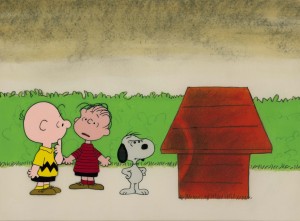
With a few well-drawn lines, Charles Schultz’s created the comic strip “Peanuts,” a world inhabited by Charlie Brown and Snoopy and his neighborhood friends, a little gang that included Linus and Lucy, Sally and Schroeder, a little red-haired girl and Franklin, and a yellow tweeter named Woodstock.
From 1950 until the artist’s retirement in 1999, children and their parents could follow story lines in newspapers from Minneapolis to Dubai that somehow fit into their own frame of reference. Schultz’s empathy with humans big and small became fodder for several television specials including “Charlie Brown Christmas” and “It’s the Great Pumpkin” and inspired the musical “You’re a Good Man Charlie Brown.
“Peanuts” ran in 2,600 newspapers in 75 countries and was translated into more than 20 languages.
Happily, 14 years after the last strip ran off the presses, “Sparky” Schultz’s insight will become more than just childhood memories. “The Art of Charles Schultz and Peanuts–The Minerd Collection” opens at the Laguna College of Art and Design on Jan. 23.
Curated by LCAD animation department co-chair David Pruiksma, 150 original pieces including drawings, letters and mementos will be on view in an extraordinary exhibition. It illuminates a multi-faceted, hands-on artist who insisted on doing all his own drawing, writing and even voice casting, though he did let the Melendez Studios in Hollywood animate Charlie Brown and company.
“Schultz first got me into drawing cartoons; he was my hero,” said Pruiksma, who met but never worked with Schultz. “I haven’t forgotten the first animated Christmas special he did in 1965,” he added.
Pruiksma first became aware of the collection through industry contacts. He approached “Peanuts” collector Scott Minerd, the chief investment officer and managing partner for Guggenheim Partners, LLC. He was instantly enthusiastic about Pruiksma’s suggestion to show selections of the Schultz trove at LCAD.
Pruiksma also found the show to be a perfect teaching tool: “I thought the ‘Peanuts’ characters were perfect for the gallery, covering disciplines like cartooning, writing, animation and even liberal arts,” he said.
Minerd’s art collecting began with drawings and paintings by European old masters, but he divested himself of these holdings in favor of more contemporary works. When he came upon the Schultz cache, he bought what he perceived as the most important pieces. “I figured Schultz had made iconic and groundbreaking art images and there were no more drawings to be made. I saw an opportunity to make an investment in something I really loved. Who does not love Snoopy?” Minerd asked.
Schultz belongs to a rarified circle of American treasures, according to Minerd, whose company is now controlling owner of the Los Angeles Dodgers. “Schultz’s work is universal. It now stands with Norman Rockwell who was first regarded as an illustrator but who now sells for millions, and Schultz is the preeminent cartoonist of the 20th century, surpassing even Walt Disney in world-wide recognition,” Minerd claimed.
Charles Solomon, a writer, animation critic and historian will conduct a lecture about his book, “The Art and Making of Peanuts Animation; Celebrating 50 Years of Television Specials” on Feb. 7 at 2 p.m. He will sign copies containing several examples from the LCAD exhibition at the lecture, which precedes the show’s opening reception from 5-9 p.m. at LCAD’s main campus, 2222 Laguna Canyon Rd.
“I had always been interested in Schultz’s animation and been surprised that so little about Peanuts had been written,” said Solomon. “What many people don’t know is how many artists, composers and musicians have been inspired by and wrote soundtracks for ‘Peanuts’,” he said.




